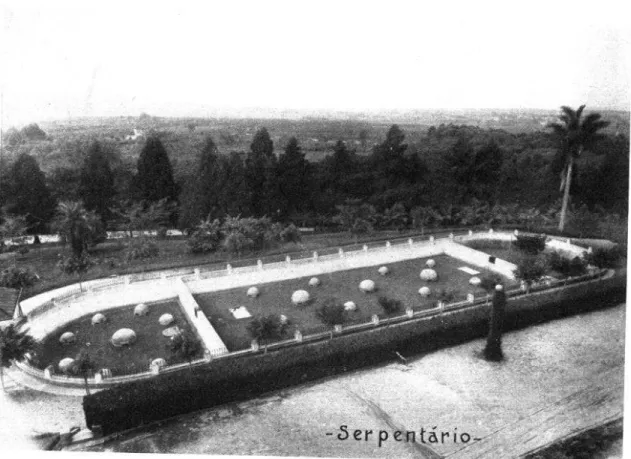StiIEMTIFIC
PNSTHTUTHQNS IN LATIN
AMERICA
THE BUTANTAN
INSTITUTEl
Director: Dr. Jayme Cavalcanti
Xão Paulo, Brazil
The ‘%utantan Institute of Serum-Therapy,” situated in the middle
of a large park on the outskirts of Sao Paulo, was founded in 1899 by
the Government of the State primarily for the purpose of preparing
plague vaccine and serum. Dr. Vital Brazil, the first Director of the
Institute, resumed there the studies on snake poisons which he had
begun in 1895 on his return from France, and his work and that of his
colleagues soon caused the Institute to become world-famous for its
work in that field.
Dr. Brazil was one of the first workers to observe the specificity of snake venom, that is, that different species of snakes have different venoms and that, therefore, different sera must be made for treating their bites. His work on snake poisons included zoological studies of the various species of snakes in the country, with their geographic distribution, biology, common names, types of venom, etc.; the prepara- tion of sera from various types of venom; the teaching of preventive
measures, including the method of capturing snakes and sending them ’
to the specialized centers; establishment of a system of exchange of live snakes for ampules of serum between the farmers and the Insti- tute; the introduction into the death certificate of an entry for the recording of snake-bite as a cause of death, and the compiling of sta- tistics of bites, treatment used, and results.
Dr. Brazil was followed in the directioqof the Institute, in 1919, by Dr. Rudolph Kraus, a noted Austrian scientist who had headed the
national bacteriological institute in Buenos Aires, and later by Dr.
Afranio do Amaral.
In addition to the manufacture of snake-bite serum and the study
and classification of snakes captured in all parts of Brazil as well as those received from other countries, the Institute carries on educational work, urging the use of leather shoes, boots and leggings by fieldworkers, the destruction of the small animals upon which snakes feed, and the use of natural enemies of snakes.
According to reports received by the Butantan Institute, of 3,080
cases of snakebite in humans, treated with anti-venom during the period 1902 to 1929, 82 died, a mortality of 2.6’7 percent. Tt has been esti-
~This ia the second of a series of srticles describing the principal scientific iostitutions in Latin America.
palero 19401 BUTANTAN
45
mated that in Sao Paulo the campaign against snakebites has saved at least 200 lives a year, the death rate from this cause having decreased from about 3 to 0.9 per 1,000 inhabitants. Smaller savings have beenobtained in animals by treatment. The studies of snakes were later
extended to other poisonous animals, such as toads, scorpions, and spiders. In a typical year, from rural districts, the following live speci- mens were received: non-poisonous snakes, 7,209; poisonous snakes, 19,828; spiders, 9,934; amphibians, 5,433; scorpions, 644; lizards, 449; and many other animals, to a value of about $4,438.00.
Although the study of snakes and manufacture of snake-bite serum and snake venom are the principal objects of the Institute, it carries on research in other fields, as shown by the scientific papers appearing in
its important annual report, Memorias do Instituto Butantan and in
special publications. Its divisions include Ophiology (study of serpents)
and Medical Zoology; Experimental Immunology, Serum-therapy and
Experimental Bacteriology; Virus and Virus-therapy; Experimental
Physics and Chemistry; Parasitology and Protozoology; Medical Botany
and Pharmacology; Experimental Chemistry and Pharmacy; Physio-
pathology, Endocrinology, and Histopathology; Cyto-embryology and
Experimental Genetics.
The manufacture of biological products is a most important activity
of the Institute. In addition to manufacturing them commercially,
it supplies the State Department of Health of São Paulo. Besides
various kinds of snake-bite and scorpion-bite sera, the Institute pre-
pared in 1938: diphtheria serum and anatoxin; tetanus serum and
anatoxin; typhoid and dysentery vaccines and sera; meningococcus
serum and vaccine; pneumonia serum and vaccine; gangrene serum; serum for the treatment of whooping-cough; smallpox vaccine; pyogenic vaccine; streptococcus serum and anatoxin; staphylococcus anatoxin; colibacillary serum; scarlet fever, and plague serum. It also prepared snake venom for use in the relief of pain, especially in cancer.
Some 30,000 tourists visit the Butantan Institute annually, most of them attracted by its snake-farm where from morning till night a large numbgr of poisonous and non-poisonous snakes may be seen. Other objects of tourist interest are the process of extracting the venom used in preparing the snake-bite serum, and the Museum in one of the
buildings with its glass cases containmg a great variety of snakes,
spiders, scorpions and lizards. Sometimes desperate struggles between
snakes may be seen, often ending in the devouring of a poisonous or non-poisonous snake by a non-venomous species such as the Mussurana (Pseudoboa cloel~a) .
46
OFICINA SANITARIA PANAMERICANA IEnerofacilities to learn the methods and observe the work of the Institute. The value of the assets, animals, products, etc. of the Institute for the year 1934 was estimated at about $172,006; the value of the products manufactured during the year, around $27,475.
An interesting illustrated account of the Institute appears in “Brazil-
ian Medical Contributions” published by the Medical Representation
OFICISA
SAXITARIA
PAKAMERICAh’A
[Enero 19401
